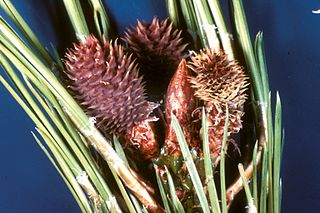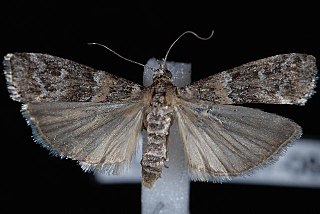
Dioryctria sylvestrella, the new pine knot-horn or maritime pine borer, is a moth of the family Pyralidae. It is found in Europe, parts of Asia and North Africa. The adult is a small mottled brown and white insect with a wingspan of 28 to 35 mm. The moth flies in a single generation from June to October and is a pest of maritime pine and several other species of pine, on which the caterpillars feed.

Dioryctria auranticella, the ponderosa pineconeworm moth, is a moth of the family Pyralidae. The species was first described by Augustus Radcliffe Grote in 1883. It is found in western North America from southern British Columbia south to California and Arizona, east to South Dakota and New Mexico.

Dioryctria ponderosae, the ponderosa twig moth, is a moth of the family Pyralidae. The species was first described by Harrison Gray Dyar Jr. in 1914. It is found in North America from Washington and Montana south to California and northern Mexico.

Dioryctria amatella, the southern pineconeworm moth, is a species of moth of the family Pyralidae. It is found in the south-eastern United States, from Maryland south to Florida and west into Texas.

Dioryctria reniculelloides, the spruce coneworm, is a moth of the family Pyralidae. The species was first described by Akira Mutuura and Eugene G. Munroe in 1973. It is found from Nova Scotia to Alaska, south in the east to New York, and south in the west to California and New Mexico. It was recorded from China in 2009. Occasionally abundant, often in conjunction with epidemics of the spruce budworm, the spruce coneworm occurs through most or all of the range of spruce in North America, feeding on new foliage and cones of spruce, and often balsam fir. When abundant, it can be a serious pest "particularly on white spruce".

Dioryctria abietivorella, the fir coneworm, is a species of snout moth in the genus Dioryctria. It was described by Augustus Radcliffe Grote in 1878, and is found in North America from southern Canada south to California in the west and North Carolina in the east.
Dioryctria aulloi is a species of snout moth in the genus Dioryctria. It was described by Barbey in 1930, and is known from Spain and India. It was recorded from China in 2009.
Dioryctria cambiicola, the western pine moth, is a species of snout moth in the genus Dioryctria. It was described by Harrison Gray Dyar Jr. in 1914 and is found in North America from British Columbia and Alberta south to California and New Mexico.
Dioryctria rossi is a species of snout moth in the genus Dioryctria. This moth was discovered and named by Dr. Douglas Alexander Ross, chief entomologist at the Vernon forest entomology laboratory and research centre in Vernon, British Columbia, from 1950 to 1970. It was described by Eugene G. Munroe in 1959. It is found in western North America, from southern British Columbia to northern Mexico and east to New Mexico.
Dioryctria fordi is a species of snout moth in the genus Dioryctria. It was described by Julian P. Donahue and Herbert H. Neunzig in 2002 and is known from the US state of California.
Dioryctria hodgesi is a species of snout moth in the genus Dioryctria. It was described by Herbert H. Neunzig in 2003 and is known from Nevada and south-eastern California in the United States.

Dioryctria okanaganella is a species of snout moth in the genus Dioryctria. It was described by Akira Mutuura, Eugene G. Munroe and Douglas Alexander Ross in 1969. It is found in western North America from southern British Columbia to northern California.
Dioryctria peltieri is a species of snout moth in the genus Dioryctria. It was described by Joseph de Joannis in 1908 and is known from Algeria.
Dioryctria pentictonella is a species of snout moth in the genus Dioryctria. It was described by Akira Mutuura, Eugene G. Munroe and Douglas Alexander Ross in 1969 and is found in North America from British Columbia south to California.
Dioryctria peyerimhoffi is a species of snout moth in the genus Dioryctria. It was described by Joseph de Joannis in 1921 and is known from Algeria and Morocco.

Dioryctria pseudotsugella is a species of snout moth in the genus Dioryctria. It was described by Eugene G. Munroe in 1959, and is known from southern British Columbia and Alberta and south to New Mexico.
Dioryctria taedivorella, the lesser loblolly pineconeworm moth, is a species of snout moth in the genus Dioryctria. It was described by Herbert H. Neunzig and Nancy Antoine Leidy in 1989, and is known from North America, where it is found from eastern Virginia and North Carolina to northern Alabama and Mississippi.
Dioryctria tumicolella is a species of snout moth in the genus Dioryctria. It was described by Akira Mutuura, Eugene G. Munroe and Douglas Alexander Ross in 1969, and is known from British Columbia, Canada, but is possibly present in all of north-western North America.
Dioryctria vancouverella is a species of snout moth in the genus Dioryctria. It was described by Akira Mutuura, Eugene G. Munroe and Douglas Alexander Ross in 1969, and is known from southern British Columbia, Canada. It is named for the city of Vancouver, from which the type specimen was collected.
Dioryctria westerlandi is a species of snout moth in the genus Dioryctria. It was described by Julian P. Donahue and Herbert H. Neunzig in 2002 and is known from the US state of California, but the range may extend into Nevada.







